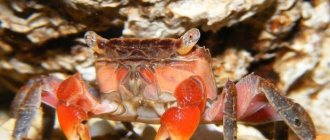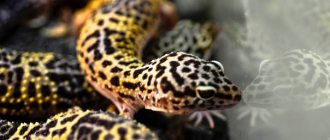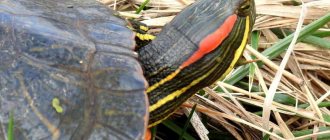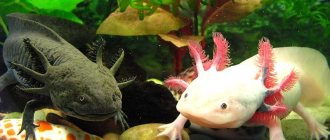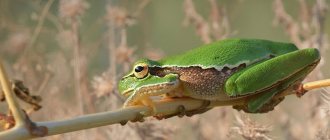The vampire crab is a small crustacean measuring only 2.5-3 cm from the genus Geosesarma, which includes land and freshwater crabs. In its natural environment, it is widespread in the tropical forests of Southeast Asia, India and the Solomon Islands. Geosesarma vampire have gained great popularity among aquarists due to their bright colors and ease of care, and they got their name due to their bright yellow eyes and bright purple coloring.
What is the most in your diet?
- Meat 43%, 152 votes
152 votes 43%152 votes - 43% of all votes
- Fruits and vegetables 24%, 85 votes
85 votes 24%
85 votes - 24% of all votes
- Dairy products and eggs 17%, 60 votes
60 votes 17%
60 votes - 17% of all votes
- Fish 17%, 59 votes
59 votes 17%
59 votes - 17% of all votes
Total votes: 356
18.04.2020
- Meat 43%, 152 votes
152 votes 43%152 votes - 43% of all votes
- Fruits and vegetables 24%, 85 votes
85 votes 24%
85 votes - 24% of all votes
- Dairy products and eggs 17%, 60 votes
60 votes 17%
60 votes - 17% of all votes
- Fish 17%, 59 votes
59 votes 17%
59 votes - 17% of all votes
Total votes: 356
18.04.2020
×
You or from your IP have already voted.
General information
A freshwater representative of the underwater world came to us from tropical countries. In their natural habitat, vampire crabs lead a predominantly terrestrial lifestyle. All dwarf crabs of the same genus received a general name. A characteristic feature is the miniature body size and bright coloring.
Exotic pets rarely go on sale, so they are difficult to find among aquarists. If someone managed to buy a couple of crabs, they are engaged in breeding interesting and curious animals at home. Moreover, maintaining them is not at all difficult.
Despite its menacing name, the vampire crab is absolutely harmless
Crabs show their character better in company. It is interesting to watch a group of vampire crabs - crustaceans will give you a lot of unforgettable impressions.
Pets become so attached to their owner that they remember his appearance and can calmly take food from his hands. Clashes over food may occur among relatives, but they never lead to injury.
There are few individuals left in nature - the species is on the verge of extinction. The fact is that vampire crabs are caught for sale. In addition, natural conditions are deteriorating, so the disappearance of natural biotopes also negatively affects their numbers.
Habitat
There are fewer and fewer representatives of this species in the wild. All of them are inhabitants of places covered with tropical rainforests. Mostly this is India, the Solomon Islands, Southeast Asia, the island of Java, and the Hawaiian Islands.
The main condition for a comfortable existence is the presence of dense thickets and water. From the aquatic environment, streams with weak currents and small calm backwaters are most suitable.
Important! Water is an important condition for normal molting of vampire crabs. These animals feel good in areas where there are mosses, ferns, and epiphytic plants.
Appearance
The strong, rounded body of the vampire crab has a carapace - a chitinous shell, 3 cm in size. There are 5 pairs of walking legs on both sides, the very first of which evolved into claws. With their help, crustaceans capture food and protect themselves from predators. The organs of vision protrude above the body - they are proudly located on movable stalks. Eye color is orange or yellow-red. The mouth with jaws is located just below the eyes.
The unusual coloring of vampire crabs attracts the eye with rich purple. The first pair of claws is paler in color than the others. A spot in the shape of a bat is clearly visible on the chitinous shell. If you follow one theory, then perhaps the species got its name thanks to this large spot.
On a note!
Vampire crabs live a short life - only 2-3 years, if favorable conditions for their existence are created.
Care and maintenance
To breed and keep 2-3 pets, you need to buy an aquarium with a volume of more than 5 liters, you can use an aquaterrarium with side dimensions of 30x20x20 cm. Crustaceans can be added to a common tank with aquarium fish or placed in a separate container.
Crabs are peaceful creatures, so neither underwater inhabitants nor aquarium plants are harmed. In the neighborhood you can choose newts for the aquarium, dwarf crayfish, fish, and shrimp.
To ensure conditions close to natural, it is recommended to install a piece of driftwood, a rock, or half a coconut in the tank, which will serve as an island. It is along this island or snag that crustaceans will rise above the surface of the water.
It is important for crabs that they have the opportunity to spend one part of the day on land and the other part underwater. It is not necessary to install heaters and a filter.
The bottom of the aquarium should be beautifully decorated with coke shavings and peat. The latter is needed so that crustaceans examine the soil and find some delicacy for themselves.
Important!
A mandatory maintenance condition is a lid on the aquarium with a small gap. A closed container will maintain a certain humidity, and the hole is necessary for air circulation.
Humidity must be monitored and try to maintain it at 70-90%. The optimal temperature range is from +24°C to +28°C.
Underwater pets love to swarm at the bottom of the aquarium, dig in the peat and build all sorts of sculptures there, which they subsequently cover with dry leaves.
If decorations, such as driftwood or leaves, are brought from the forest, under no circumstances should they be immediately sent to the aquarium. Before decorating the tank with them, the elements will have to be doused with boiling water to kill all microorganisms. If you neglect this advice, the parasites, fungi, bacteria present in the forest products will destroy the crustaceans.
Vampire crabs are not known for their whimsical maintenance.
Spreading
The natural range of the Maltese freshwater crab is extremely fragmented, comprising parts of various countries along the Mediterranean coast. This species is found on the Apennine Peninsula, in the Balkans from Dalmatia to the Vardar River in Greece. Also lives on islands such as: Sicily, Malta, Gozo, the Ionian Islands, the Aegean Islands, the Northern Sporades, as well as the island of Andros from the Cyclades group. It is also found in the Krasnodar region of Russia. Although the species is generally widespread, its numbers are declining and these island populations are partially vulnerable.
Italy
The Maltese freshwater crab is widespread in the western part of the Apennine Peninsula, in the regions of Trentino-Alto Adige, Lombardy, Venice, Liguria, Tuscany, Umbria, Lazio, Campania, Apulia and Calabria. Also common on the island of Sicily. It is not now found north of the Po River, although Lake Garda was previously the northern limit of its range.
In 1997, in the center of Rome, under the ruins of Trajan's Forum, a population of Maltese freshwater crab was discovered. Here crabs lived in canals built by the Etruscans and connected to the Great Cloaca. This is likely the only population of any freshwater crabs found in a large city. Genetic analysis showed the relationship of the discovered crabs with the Greek representatives of the species. It is believed that the Greeks brought them here about 3,000 years ago, even before the founding of Rome. The unusually large size of Roman crabs (up to 12 cm), as well as their longevity (living up to 15 years), are explained by a phenomenon similar to “island gigantism”, and are also considered evidence that this population has existed for a long time.
Malta
In Malta, this species is rare, distributed only in some places in the west of the island. Since 1993 it has been protected by law.
On the island of Gozo there is a separate population living in a section of the river only 700 meters long.
Balkans
On the Balkan Peninsula it is found in Croatia, Montenegro, the Republic of Macedonia, Albania and Greece. In the Balkans there are 4 species of the genus “Potamon”; in north-eastern Greece, instead of the Maltese freshwater crab, its closest relative, Potamon ibericum, lives. In mainland Greece, the Maltese freshwater crab is found in the basins of the Vardar, Thiamis, Acheron, Arachthos, Pineios, Pyros Tetreas, Pamisos and Eurotas rivers.
In the Ionian Islands, only one habitat is known in Corfu, the same pattern is observed in Kefalonia, Lefkada and Zakynthos. From the islands of the Aegean Sea it is found on Skiathos and Skopelos (Northern Sporades), as well as on the islands of Euboea and Skyros. One habitat is known on the island of Andros (Cyclades).
The crab was also spotted on the island of Cyprus, in a mountain stream at the foot of the Troodos Mountains.
Compatibility
When kept in an aquarium, a vampire crab needs to create an island so that it can spend a lot of time on land, because in their natural habitat crustaceans both swim and crawl on the ground. Therefore, keeping them together with aquarium fish is extremely undesirable, since it will be difficult to create good conditions for keeping them. If you manage to bring the conditions closer to natural ones, the crabs behave peacefully and get along with even the smallest inhabitants: the aquarium snail, shrimp and guppies.
Nutrition
Vampyroteuthis infernalis or hellish vampire squid
The diet of crabs should combine plant and live foods. The crab eats quite a lot, especially fresh greens. This leads to sad consequences for aquarium plants, so there should be quite a lot of them in the aquarium from the very beginning, as they help remove nitrates that are harmful to the health of the crabs. Water hyacinth, hornwort, elodea, Java moss, Wolffia and floating plant species are suitable.
The best way is to feed them fruit in the form of banana or apple slices, boiled vegetables, lettuce, dandelion, spinach and nettles.
Among live foods, preference is given to squid and fish meat, offal, snails, tubifex and bloodworms. But excessive consumption of such food is fraught with water pollution with nitrogen compounds dangerous to the health of crabs.
Return to content
Soil and design of the aquaterrarium
Crustaceans spend most of their time on land, so it is recommended to make a small island in the aquaterrarium - a piece of land with a gentle slope, so that the crabs can easily crawl onto it and rest.
As shelters, you can choose decorative driftwood, stones, coconut shells, and dry leaves. It is recommended to place Java moss or hornwort between the towering decorative elements. Crustaceans are calm about green spaces, so it doesn’t matter how many of them are planted in the aquarium - they will not touch the algae.
As a soil for arranging a piece of land, you can take a mixture of coconut crumbs with clay and peat. The latter is necessary for crabs, like air. They love to dig through it and look for treats for themselves. The water part of the aquaterrarium must be filled with small pebbles or expanded clay.
Every week it is recommended to change the water in the aquarium where crustaceans live. If you miss it once and do not replace some of the liquid, the animals may die, since toxic substances accumulate in the water during the life of underwater inhabitants.
While adding new water, siphon the substrate. It is recommended to stand new water taken from the tap for several days so that the chlorine evaporates. If it is not possible to settle, you can add conditioner to the water. In addition to cleansing the fluid, the drug saturates it with magnesium and iodine, which are so necessary for molting.
Be sure to provide the crabs with a variety of hiding places.
Business registration
Any business should start with state registration. If business activity is not registered in the prescribed manner, it may be considered illegal and the entrepreneur will be fined. In addition, without documents you should not count on selling large quantities of finished products and concluding profitable deals.
The activity of growing crustaceans is classified as fish farming. Depending on the type of water (sea or fresh) where the animals will be kept, the application for business registration should indicate code 03.21 “Marine fish farming” or 03.22 “Freshwater fish farming”. These codes are generally accepted; they are prescribed in the OKVED classifier of types of economic activity. Both individual entrepreneurs (it is useful to read how to register an individual entrepreneur yourself) and legal entities can engage in this business (see the procedure for registering a legal entity). This does not require a license.
Feeding the vampire crab
Crustaceans are not picky about their diet. If you take a closer look at them and observe them for a certain time, you will notice that they are constantly working with their jaws - chewing food, sorting through peat with the remains of sphagnum moss. Even if you leave your pets for several days, they will not disappear, as they will find food for themselves.
But they won’t be satisfied with peat alone. Crabs need a balanced diet containing protein. Crustaceans are gluttonous, so you will have to control the amount of food released so as not to overfeed your pets.
As for dry food for underwater inhabitants, it is recommended to purchase the Terra Crusta series. Balanced food contains animal and plant products, vitamins and minerals to strengthen the immune system. You can buy Terra WaferMix tablets. Although they are intended for catfish, crabs eat them with pleasure.
Crustaceans should be fed 3 times every 7 days and given:
- coretra;
- Artemia;
- small frozen bloodworms;
- finely chopped squid;
- mussels;
- shrimp;
- fish.
To supplement and enrich your diet, it is recommended to include fruits and vegetables with tender pulp in your menu. These are melons, peaches, bananas, cucumbers, tomatoes.
Vampire crabs need calcium to strengthen their shell. To meet the need for the mineral, you need to include cottage cheese, chalk and vitamin-mineral complexes in your diet.
It is better to feed in a specially designated container so as not to pollute the soil. You can put a shell as a plate. It will not only be an organic part of the decor, but will also allow you to easily remove and wash the “plate” of food.
Sometimes small crabs can lose their limbs. This is not a problem, and there is no need to worry about this, since after molting they will grow back.
Attention!
Before molting, crabs try to hide in a secluded place so that their owners do not see them.
Vampire crabs are omnivores
Registration with tax authorities
The business must be registered with the tax authority. This must be done before the start of trading operations. At the initial stages of creating and breeding seafood, there is no such need. Tax accounting is important when concluding agreements and contracts for supplied products. Which form of tax accounting to choose? The businessman decides the issue on his own.
Organizing an individual business has advantages over a limited liability company: registration will be cheaper. Shrimp and crab farming activities are classified as fish farming. A license is not required for this type of activity. Relevant documents from the SES and Rospotrebnadzor are required, since seafood belongs to the category of food products and is sold for trade.
Reproduction and breeding
Breeding crabs at home is easy to do. They feel great and give birth, but only if they live in comfortable conditions. Individuals of different sexes should be placed in the aquaterrarium. Females and males have one important difference, by which it is easy to determine their gender. You need to turn the pet upside down and look at its shape. If it is wide, it is a female, if it is narrow, it is a male.
Crustaceans become sexually mature when they reach 6-8 months of age. When the female reaches sexual maturity, she is ready to give birth to offspring 2 times a year. At one time, the female carries 50 eggs. Crabs do not have a larval stage, as they lead a predominantly terrestrial lifestyle. Fully formed babies emerge from the eggs. Their body length is 1 mm. They are painted gray and only after several molts the color becomes permanent - purple.
Sexual characteristics
If you look at the abdomen of a male and a female, the male has a narrow abdomen, the female has a wide abdomen. In addition, the male specimen has a large claw.
How to buy correctly
Before purchasing a pet from the seller, you should clarify the origin of the crab - imported or local. If the baby came from the tropics, most likely, its life will not last long, since crustaceans are difficult to transport and do not adapt well to our conditions. It is better if the pet is locally bred.
The smaller the crab, the better. Babies quickly adapt to new living conditions. Brightly colored individuals are already adults or old, so they will not live long.
When buying a crab from a local aquarist, you should know that domestic pets are resilient guys, so they will quickly get used to the new owner and will delight you with their swarming in the aquaterrarium.
It is very easy to get offspring from vampire crabs at home.
Vampire crabs are purple, less often orange.,
flexible character and original appearance. Thanks to their friendly nature, even despite their frightening appearance, pets soon become beloved animals and delight their owners.
Would you like to buy a vampire crab for your own aquarium? Share in the comments!
